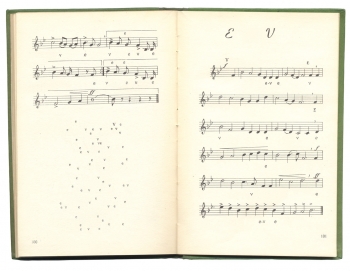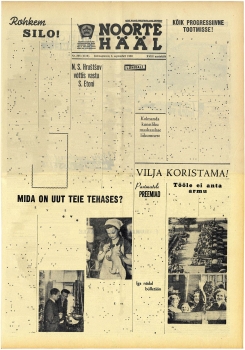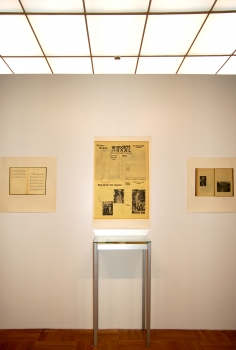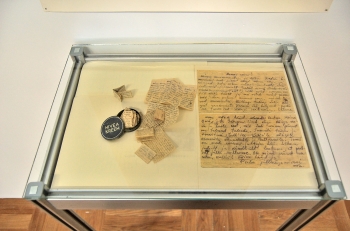EV [e-ve]
Solo show in Tallinn Art Hall, 2008
EV = Eesti Vabariik – the Estonian Republic (pronounced e-ve in Estonian)
This work is about my first name, into which my father encoded the Estonian Republic in 1958. This is a work of hope, about belief in freedom and self-government, which has been so important to Baltic people in the 20th century. It is also about hidden messages, encoded between the lines, which was characteristic of the circumstances of occupation and lack of freedom of speech.
My father was born in 1918 – the same year Estonia declared its independence. In 1944 he was arrested by the Secret Police and sent to Vorkuta, the infamous Soviet-Russian prison camp for 10 years. Father never mentioned that he named me after the Estonian Republic – I read about it after he had passed away, in 1990 during the Singing Revolution, in a letter he had written to his friend from school: [---] in August of 1957 I married that same Asta, with whom I became acquainted due to circumstances of the bomb raid of 1944. In September of 1958 our daughter was born, who we named EVE (read it front to back or the other way, it’s still EV – I named her that to honour and celebrate Eesti Vabariik). [---]
The following were used as inspiration for the triptych:
1. The national anthems of the Soviet Union and the Soviet Socialist Republic of Estonia as printed in the songbook “Songbook. Songs for Grade 2”, published by the Estonian State Publishing House in 1958,
2. The issue of the newspaper “Noorte Hääl” (Voice of Youth) from my birthday – September 3, 1958,
3. The book “History of the Estonian SSR for Secondary School, Grades IX-XI”, published in 1959. On the left-hand page is an image of Johannes Vares Barbarus – a leftist Estonian poet who became prime minister of the Communist “puppet government” in 1940 when Estonia was occupied by the Soviet Union. The cause of his death is 1946 is shrouded in mystery; supposedly he committed suicide or was murdered. On the right-hand page is a well-known photo of Freedom Square, where “grandiose performances” took place in June and July of 1940 – Estonia’s supposed voluntary joining of the Soviet Union was played out here, under the direction of Moscow. Paradoxically there were only 140 Communist Party members in Estonia in 1940.
Eve Kask, 2008
Solo show in Tallinn Art Hall, 2008
EV = Eesti Vabariik – the Estonian Republic (pronounced e-ve in Estonian)
This work is about my first name, into which my father encoded the Estonian Republic in 1958. This is a work of hope, about belief in freedom and self-government, which has been so important to Baltic people in the 20th century. It is also about hidden messages, encoded between the lines, which was characteristic of the circumstances of occupation and lack of freedom of speech.
My father was born in 1918 – the same year Estonia declared its independence. In 1944 he was arrested by the Secret Police and sent to Vorkuta, the infamous Soviet-Russian prison camp for 10 years. Father never mentioned that he named me after the Estonian Republic – I read about it after he had passed away, in 1990 during the Singing Revolution, in a letter he had written to his friend from school: [---] in August of 1957 I married that same Asta, with whom I became acquainted due to circumstances of the bomb raid of 1944. In September of 1958 our daughter was born, who we named EVE (read it front to back or the other way, it’s still EV – I named her that to honour and celebrate Eesti Vabariik). [---]
The following were used as inspiration for the triptych:
1. The national anthems of the Soviet Union and the Soviet Socialist Republic of Estonia as printed in the songbook “Songbook. Songs for Grade 2”, published by the Estonian State Publishing House in 1958,
2. The issue of the newspaper “Noorte Hääl” (Voice of Youth) from my birthday – September 3, 1958,
3. The book “History of the Estonian SSR for Secondary School, Grades IX-XI”, published in 1959. On the left-hand page is an image of Johannes Vares Barbarus – a leftist Estonian poet who became prime minister of the Communist “puppet government” in 1940 when Estonia was occupied by the Soviet Union. The cause of his death is 1946 is shrouded in mystery; supposedly he committed suicide or was murdered. On the right-hand page is a well-known photo of Freedom Square, where “grandiose performances” took place in June and July of 1940 – Estonia’s supposed voluntary joining of the Soviet Union was played out here, under the direction of Moscow. Paradoxically there were only 140 Communist Party members in Estonia in 1940.
Eve Kask, 2008




